![]()
![]()
![]()
Use LEFT and RIGHT arrow keys to navigate between flashcards;
Use UP and DOWN arrow keys to flip the card;
H to show hint;
A reads text to speech;
67 Cards in this Set
- Front
- Back
|
Impressionism: oil paints in tubes |

The paint tube was invented in 1841 by portrait painter John Goffe Rand. Artists, or their assistants, previously ground each pigment by hand, carefully mixing the binding oil in the proper proportions. Paints could now be produced in bulk and sold in tin tubes with a cap. The cap could be screwed back on and the paints preserved for future use, providing flexibility and efficiency to painting outdoors. Paint in tubes also changed the way some artists approached painting. The artist Pierre-Auguste Renoir said, “Without tubes of paint, there would have been no Impressionism.” For the Impressionists, tubed paints offered an easily accessible variety of colors for their plein air palettes, motivating them to make spontaneous color choices. |
|
|
Impressionism: portable easels |

An easel is an upright support used by artists to hold a canvas. There are two basic designs- the H Frame and the Tripod. Both designs can adjust to accommodate different angles, are a collapsible for easy transport and storage . The H frame design has four vertical posts and is structured around ninety degree angles, while the Tripod has three posts and easily enable vertical adjustments. Easels were not always collapsible and portable. As easels became portable, it enabled impressionist artists to paint in various outside locations without hassle. This perpetuated the painting of landscapes and led to a greater focus on the effects of light. |
|
|
Impressionism: cobalt blue and violet |
The Impressionists created violet by glazing cobalt blue or ultramarine with red, or by using new cobalt and manganese violet pigments that had become available to artists. |
|
|
Impressionism: plein air |
is a French expression which means "in the open air" and is particularly used to describe the act of painting outdoors. It can also be used to describe other activities where a person partakes in an outdoor environment. Artists have long painted outdoors, but in the mid-19th century working in natural light became particularly important to the Barbizon schooland Impressionism. |
|
|
Impressionism: local color |
As the dominant element of the painting, local color refers to the true color of subjects, e.g. green grass or blue sky. |
|
|
Impressionism: color theory |
Advanced in color theory were leading the Impressionists to experiment with pigments. Science has shown that the color white is composed of primary colors. This inspired artists to mix primary pigments directly on their canvases in order to achieve additive color effects. Using a palette of just eight to ten colors they were able to achieve many variable and subtle effects. |
|
|
Impressionism: japonisme |

is the influence of Japanese art, fashion and aesthetics on Western culture. The term is used particularly to refer to Japanese influence on European art, especially in impressionism. |
|
|
Impressionism: japonaiserie |
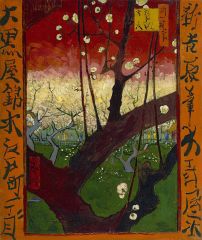
was the term the Dutch post-impressionist painter Vincent van Gogh used to express theinfluence of Japanese art. |
|
|
Impressionism: woodblock prints |

is a technique for printing text, images or patterns used widely throughout East Asia and originating in China in antiquity as a method of printing on textiles and later paper. |
|
|
Impressionism: Commodore Perry |
United States admiral who led a naval expedition to Japan and signed a treaty in 1854 opening up trade relations between United States and Japan. |
|
|
Impressionism: Monet’s haystack series |
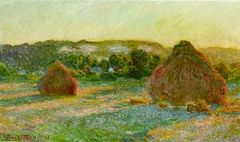
is a title of a series of impressionist paintings by Claude Monet. The primary subjects of all of the paintings in the series are stacks of hay in the field after the harvest season. The title refers primarily to a twenty-five canvas series begun in the end of summer of 1890 and continued through the following spring, using that year's harvest. The series is known for its thematic use of repetition to show differences in perception of light across various times of day, seasons, and types of weather. The subjects were painted in fields near Monet's home in Giverny, France. |
|
|
Post-Impressionism: multiple perspectives |
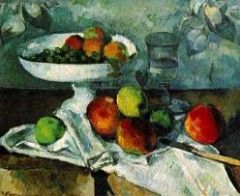
a broad term to encompass multiple and possibly heterogeneous viewpoints, representations and roles, that can be adopted within both a collaborative and non-collaborative context. |
|
|
Post-Impressionism: pointillism |
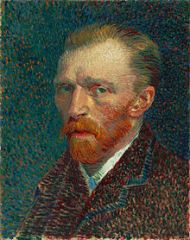
is a technique of painting in which small, distinct dots of pure color are applied in patterns to form an image. |
|
|
Post-Impressionism: foreground |
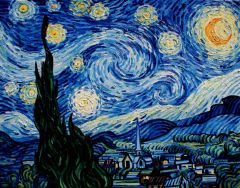
the part of a view that is nearest to the observer, especially in a picture or photograph. |
|
|
Post-Impressionism: middle-ground |
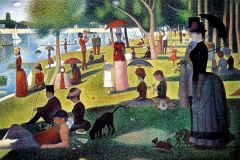
an area of compromise or possible agreement between two extreme positions, especially political ones. |
|
|
Post-Impressionism: background |
the area or scenery behind the main object of contemplation, especially when perceived as a framework for it. |
|
|
Post-Impressionism: primitive |
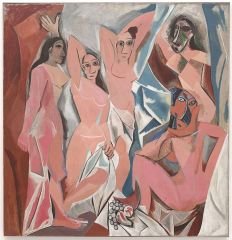
Primitivism is a Western art movement that borrows visual forms from non-Western or prehistoric peoples, such as Paul Gauguin's inclusion of Tahitian motifs in paintings and ceramics. Borrowings from primitive art has been important to the development of modern art. |
|
|
Post-Impressionism: synchronization |
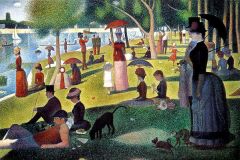
|
|
|
Symbolism: Edgar Allen Poe |
was an American author, poet, editor, and literary critic, considered part of the American Romantic Movement. Best known for his tales of mystery and the macabre, Poe was one of the earliest American practitioners of the short story, and is generally considered the inventor of the detective fiction genre. He is further credited with contributing to the emerging genre of science fiction. |
|
|
Symbolism: irrational |
Surrealism originated in the late 1910s and early '20s as a literary movement that experimented with a new mode of expression called automatic writing, or automatism, which sought to release the unbridled imagination of the subconscious. The cerebral and irrational tenets of Surrealism find their ancestry in the clever and whimsical disregard for tradition fostered by Dadaism a decade earlier. |
|
|
Symbolism: Gaugain |
was a leading French Post-Impressionist artist who was not well appreciated until after his death. Gauguin was later recognized for his experimental use of color and synthetist style that were distinguishably different from Impressionism. He was an important figure in the Symbolist movement. |
|
|
Expressionism: fin de siècle |
is French for end of the century. The term typically encompasses not only the meaning of the similar English idiom turn of the century, but also both the closing and onset of an era, as the end of the 19th century was felt to be a period of degeneration, but at the same time a period of hope for a new beginning |
|
|
Expressionism: Van Gogh |
was a post-Impressionist painter of Dutch origin whose work—notable for its rough beauty, emotional honesty, and bold color—had a far-reaching influence on 20th-century art. After years of painful anxiety and frequent bouts of mental illness |
|
|
Art Nouveau/Modernisme/Jugendstijl – organic |
stylised organic forms as a source of inspiration, expanding the 'natural' repertoire to use seaweed, grasses, and insects. |
|
|
Art Nouveau/Modernisme/Jugendstijl – hand-crafted |
????????? |
|
|
Fauvism: “wild beasts” |
Fauvism is the style of les Fauves (French for "the wild beasts"), a loose group of early twentieth-century Modern artists whose works emphasized painterly qualities and strong color over the representational or realistic values retained by Impressionism. While Fauvism as a style began around 1900 and continued beyond 1910, the movement as such lasted only a few years, 1904–1908, and had three exhibitions. |
|
|
German Expressionism (Die Brucke/Der Blau Reiter): Franz Marc |
was a German painter and printmaker, one of the key figures of the German Expressionist movement. He was a founding member of Der Blaue Reiter (The Blue Rider), a journal whose name later became synonymous with the circle of artists collaborating in it. |
|
|
German Expressionism (Die Brucke/Der Blau Reiter): Kandinsky |
was an influential Russian painter and arttheorist. He is credited with painting the first purely abstract works. He enrolled at the University of Moscow, studying law and economics. Successful in his profession—he was offered a professorship at the University of Dorpat—he began painting studies (life-drawing, sketching and anatomy) at the age of 30. |
|
|
German Expressionism (Die Brucke/Der Blau Reiter): synesthesia |
is a neurological phenomenon in which stimulation of one sensory or cognitive pathway leads to automatic, involuntary experiences in a second sensory or cognitive pathway.People who report such experiences are known as synesthetes. |
|
|
Cubism: Picasso |
As one of the greatest and most influential artists of the 20th century, he is known for co-founding the Cubist movement, the invention of constructed sculpture, the co-invention of collage, and for the wide variety of styles that he helped develop and explore. |
|
|
Cubism: Braque |
was a major 20th-century French painter, collagist, draughtsman, printmaker and sculptor. His most important contributions to the history of art were in his alliance with Fauvism from 1906, and the role he played in the development of Cubism. Their respective Cubist works were indistinguishable for many years, yet the quiet nature of Braque was partially eclipsed by the fame and notoriety of Picasso. |
|
|
Cubism: Hermetic |
Hermetic cubism is a more extreme version of analytical cubism. The background and the foreground the paintings are indistinguishably fused together and the facets are more split. Hermetic paintings have the illusion of a painting viewed through a shattered mirror because although there are traces of the original object, they are spread so widely throughout the canvas that it seems almost indistinguishable. The planes on hermetic canvases are often monochromatic with sections of shadow, shading, and dark marks to identify segments of the still life. |
|
|
Cubism: Synthetic, multiple perspectives, primitivism, Cezanne, Spanish Civil War |
Synthetic Cubism grew out of Analytic Cubism. It was developed by Pablo Picasso and Georges Braque. Picasso and Braque discovered that through the repetition of "analytic" signs their work became more generalized, more geometrically simplified and flatter. Overlapping planes sometimes shared one color (passage). Real pieces of paper replaced painted flat depictions of paper. Real scores of music replaced drawn musical notation. Fragments of newspaper, playing cards, cigarette packs, and advertisements that were either real or painted interacted on the flat plane of the canvas as the artists tried to achieve a total interpenetration of life and art. |
|
|
Cubism: Cezanne, Spanish Civil War |
as a French artist and Post-Impressionist painter whose work laid the foundations of the transition from the 19th-century conception of artistic endeavour to a new and radically different world of art in the 20th century. Cézanne's often repetitive, exploratory brushstrokes are highly characteristic and clearly recognizable. Cézanne can be said to form the bridge between late 19th-century Impressionism and the early 20th century's new line of artistic enquiry, Cubism. |
|
|
Cubism: Spanish Civil War |
was fought from 17 July 1936 to 1 April 1939 between the Republicans, who were loyal to the democratically elected Spanish Republic, and the Nationalists, a rebel group led by General Francisco Franco. The Nationalists prevailed, and Franco ruled Spain for the next 36 years, from 1939 until his death in 1975. |
|
|
Futurism: futurist manifesto |
written by the Italian poet Filippo Tommaso Marinetti, was published in the Italian newspaperGazzetta dell'Emilia. It initiated an artistic philosophy, Futurism, that was a rejection of the past, and a celebration of speed, machinery, violence, youth and industry; it was also an advocation of the modernization and cultural rejuvenation of Italy. |
|
|
Futurism: modern life |
Futurism was a movement aware of the effects of modern life and the key to understanding Futurism is the idea of a complete renewal of human sensibility brought about by modern science. |
|
|
Futurism: WWI |
was a global war centred in Europe that began on 1914 and lasted 1918. More than 9 million combatants and 7 million civilians died as a result of the war, a casualty rate exacerbated by the belligerents' technological and industrial sophistication, and tactical stalemate. It was one of the deadliest conflicts in history, paving the way for major political changes, including revolutions in many of the nations involved. |
|
|
Dada: Duchamp |
was a French-American painter, sculptor and writer whose work is associated with Dadaism and conceptual art, although not directly associated with Dada groups. Duchamp is commonly regarded, along with Pablo Picasso and Henri Matisse, as one of the three artists who helped to define the revolutionary developments in the plastic arts in the opening decades of the twentieth century, responsible for significant developments in painting and sculpture.Duchamp has had an immense impact on twentieth-century and twenty first-century art. By World War I, he had rejected the work of many of his fellow artists as "retinal" art, intended only to please the eye. |
|
|
Dada: Arp |
was a German-French, or Alsatian, sculptor, painter, poet and abstract artist in other media such as torn and pasted paper.
|
|
|
Dada: nihilistic |
rejecting all religious and moral principles in the belief that life is meaningless. |
|
|
Dada: anti-retinal |
Duchamp explains his anti-retinal bias in terms of his effort to expand and to return to the original meaning of painting not as visual/erotic stimulation but as conceptual intervention, one that puts the painter on the same level with the philosopher. |
|
|
Surrealism: Freud |
was an Austrian neurologist who became known as the founding father of psychoanalysis. |
|
|
Surrealism: automatic drawing |
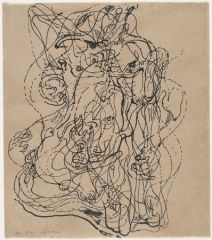
Automatism has taken on many forms: the automatic writing and drawing initially practiced by surrealists can be compared to similar, or perhaps parallel phenomena, such as the non-idiomatic improvisation. Surrealist automatism is different from mediumistic automatism, from which the term was inspired. Ghosts, spirits or the like are not purported to be the source of surrealist automatic messages. |
|
|
Surrealism: psyche |
A medical doctor, Sigmund Freud, discovered the "psyche" or "soul," while trying to find the cause of his patients' unusual symptoms. Psyche is the Greek equivalent for Anima, the Latin word for soul. Both refer to something metaphysical–beyond the physical, invisible to our eyes. |
|
|
Surrealism: unconscious |
Where most of the psychology of the past century did its best to ignore this divided subject, writers and artists have been the main groupings outside the world of psychoanalysis to acknowledge the facts of the unconscious. Today's market-led societies have less and less space for the idea that a part of human activity does not serve instrumental aims such as the acquisition of wealth, power or happiness. They don't want to know about unconscious desire, infantile sexuality, hatred, self-destruction and despair. |
|
|
De Stijl: Mondrian |
was a Dutch painter. He was an important contributor to the De Stijl art movement and group, which was founded by Theo van Doesburg. He evolved anon-representational form which he termed neoplasticism. This consisted of white ground, upon which was painted a grid of vertical and horizontal black lines and the three primary colors. |
|
|
De Stijl: Neo-Plasticism |
also known as De Stijl was a Dutch artistic movement founded in 1917 in Amsterdam. The De Stijl consisted of artists and architects. In a narrower sense, the term De Stijl is used to refer to a body of work from 1917 to 1931 founded in the Netherlands. |
|
|
De Stijl: reduction of form |
Reductive art is a term to describe an artistic style or an aesthetic, rather than an art movement. Movements and other terms associated with reductive art include Minimal art,ABC art, anti-illusionism, cool art, rejective art, Bauhaus aesthetic, work that emphasizes clarity, simplification, reduced means, reduction of form, streamlined composition, primary shapes, and restricted color. It is also characterized by the use of plain-spoken materials, precise craftsmanship and intellectual rigor. |
|
|
De Stijl: universal art |
De Stijl always sought universality and absoluteness. The aim of the movement was to make the abstract concrete and, through this materialization, it would change the world. |
|
|
De Stijl: purity |
Their works of art therefore did not simply reflect the incidental state of mind of the artist but helped the public along the path to truth and purity. |
|
|
American Regionalism: FSA |

Social realist photography reached a culmination for the Farm Security Administration (FSA) project. After World War I the booming U.S. farm economy collapsed from overproduction, falling prices, unfavorable weather, and increased mechanization.Many farm laborers were out of work and many small farming operations were forced into debt. Almost two million farm families lived in poverty. he FSA was a New Deal agency designed to combat rural poverty during this period. The agency hired photographers to provide visual evidence that there was a need, and that FSA programs were meeting that need. |
|
|
American Regionalism: rural American WWII |
The Depression changed the lives of people who lived throughout rural America. The Depression in rural America actually began a decade before the Great Depression. The United States experienced after World War I experienced recession followed by a severe depression. Urban America quickly recovered and enjoyed a decade of economic expansion and growth. Rural America never recovered. And this was made even worse when the farmers on the Great Plains had to contend with a severe drought. Unappreciated by the pioneers that settled on the Great Planes after the Civil War, they were settling down on a fragile environmental system. |
|
|
American Regionalism: Dust Bowl |
also known as the Dirty Thirties, was a period of severe dust storms that greatly damaged the ecology and agriculture of the US and Canadian prairies during the 1930s; severe drought and a failure to apply dry land farming methods to prevent wind erosion caused the phenomenon. |
|
|
American Regionalism: Great Depression |
was a severe worldwide economic depression in the decade preceding World War II. The timing of the Great Depression varied across nations, but in most countries it started in 1930 and lasted until the late 1930s or middle 1940s. It was the longest, deepest, and most widespread depression of the 20th century. |
|
|
American Regionalism: 1913 Armory show |
International Exhibition of Modern Art that was organized by the Association of American Painters and Sculptors, the first large exhibition of modern art in America.The show became an important event in the history of American art, introducing astonished Americans, who were accustomed to realistic art, to the experimental styles of the European avant garde, including Fauvism, Cubism, and Futurism. |
|
|
International Style: Bauhaus |
The Bauhaus was founded in 1919 in the city of Weimar by German architect Walter Gropius. Its core objective was a radical concept: to reimagine the material world to reflect the unity of all the arts. Gropius explained this vision for a union of art and design in the Proclamation of the Bauhaus, which described a utopian craft guild combining architecture, sculpture, and painting into a single creative expression. |
|
|
International Style: Walter Gropius |
was a German architect and founder of the Bauhaus School, is widely regarded as one of the pioneering masters of modern architecture. |
|
|
International Style: Mies van der Rohe |
was a German-American architect. He is widely regarded as one of the pioneering masters of modern architecture. He created an influential twentieth-century architectural style, stated with extreme clarity and simplicity. His mature buildings made use of modern materials such as industrial steel and plate glass to define interior spaces. He strove toward an architecture with a minimal framework of structural order balanced against the implied freedom of free-flowing open space. He called his buildings "skin and bones" architecture. |
|
|
International Style: steel I-beams |
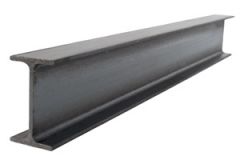
is a beam with an I- or H-shaped cross-section. The horizontal elements of the "I" are known as flanges, while the vertical element is termed the "web". I-beams are usually made of structural steeland are used in construction and civil engineering. |
|
|
International Style: universal space |

The term ‘universal space’ was first proposed by Mies van der Rohe to describe a kind of long-span single-volume flexible enclosure. In order to explain the concept, he used an interior photograph of the Glenn Martin Aircraft Assembly Building, designed by Albert Kahn in 1937, as a backdrop for a montage onto which he superimposed a number of free standing planes to represent walls and ceilings that could be moved to suit changing requirements. |
|
|
International Style: form follows function |
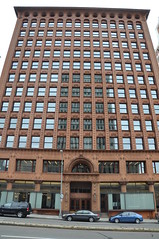
is a principle associated with modernist architecture and industrial design in the 20th century. The principle is that the shape of a building or object should be primarily based upon its intended function or purpose. |
|
|
Abstract Expressionism: gestural painting |
A term describing the application of paint with expansive gestures so that the sweep of the artist's arm is deliberately emphasized. It carries an implication that the artist's actions express his or her emotions and personality, just as in other walks of life gestures express a person's feelings. The term has been applied particularly to Abstract Expressionism and is sometimes used more or less as a synonym for Action Painting. However, it can also apply to figurative painting, notably Neo-Expressionism. |
|
|
Abstract Expressionism: color field painting |
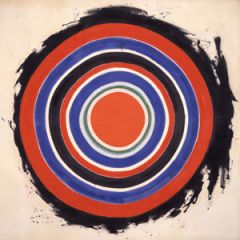
is a style of abstract painting that emerged in New York City during the 1940s and 1950s. It was inspired by European modernism and closely related to Abstract Expressionism, while many of its notable early proponents were among the pioneering Abstract Expressionists. Color Field is characterized primarily by large fields of flat, solid colorspread across or stained into the canvas creating areas of unbroken surface and a flat picture plane. The movement places less emphasis on gesture, brushstrokes and action in favour of an overall consistency of form and process. In color field painting "color is freed from objective context and becomes the subject in itself." |
|
|
Abstract Expressionism: WWII |
was a global war that lasted from 1939 to 1945, though related conflicts began earlier. It involved the vast majority of the world's nations. |
|
|
Abstract Expressionism: action painting |
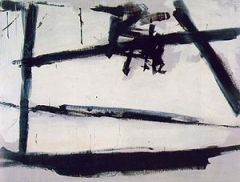
is a style of painting in which paint is spontaneously dribbled, splashed or smeared onto the canvas, rather than being carefully applied. The resulting work often emphasizes the physical act of painting itself as an essential aspect of the finished work or concern of its artist. |
|
|
Abstract Expressionism: process vs product |
Process art is an artistic movement as well as a creative sentiment where the end product of art and craft, the objet d’art, is not the principal focus. The 'process' in process art refers to the process of the formation of art: the gathering, sorting, collating, associating, patterning, and moreover the initiation of actions and proceedings. Process Art is concerned with the actual doing and how actions can be defined as an actual work of art; seeing the art as pure human expression. Process art often entails an inherent motivation, rationale, and intentionality. Therefore, art is viewed as a creative journey or process, rather than as a deliverable or end product. |

